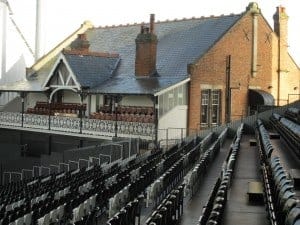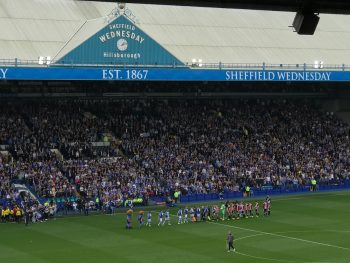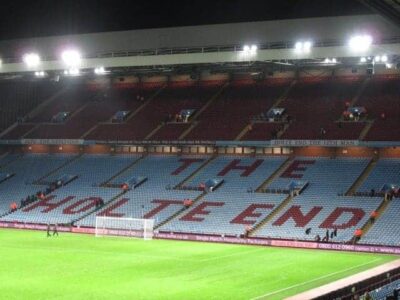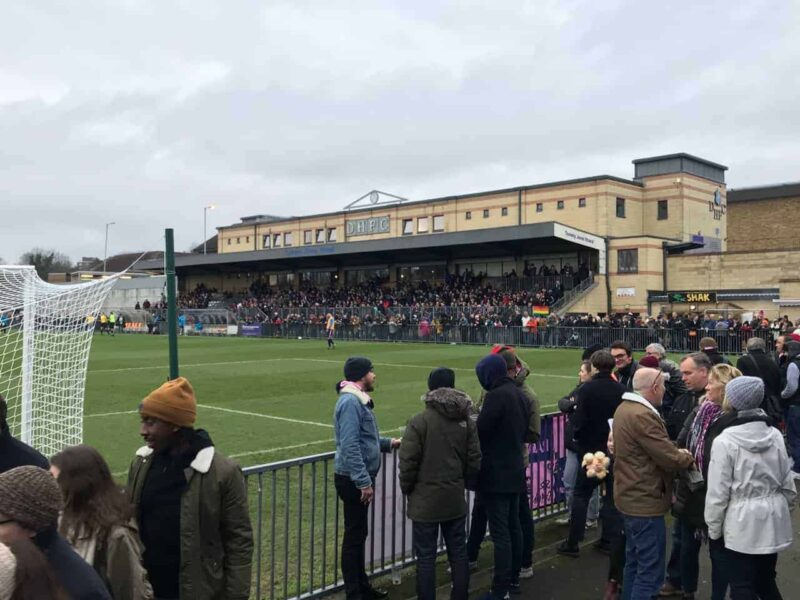It should go without saying that we at Groundhopper Guides love us some English football…
A Guide to the Must See Historic Football Stadiums in England

One of the best things about seeing games in person is that many of the English football stadiums are worthy destinations in their own right. So here’s our football ground guide of stadiums in England that we think should be at the top of your groundhopping wish list.
What makes English Football Grounds so Great?
Stadiums can be all sorts of shapes, sizes and styles, and they can have very different sets of characteristics. Many English clubs are building fancy modern homes, like the new Tottenham Hotspur Stadium.
For us at Groundhopper Soccer Guides, though, it’s all about the historic soccer stadiums in England, the ones that have housed their clubs for many decades. They aren’t the most comfortable, but they are right in the middle of town, are beloved by fans, and are a part of the fabric of their club.
The Older English Football Stadiums Are Being Replaced
For about twenty years now, England has been engaging in a slow-motion bad idea—similar to something America did in the 1960s and 1970s. They are tearing down old grounds full of character and history, but lacking in space and facilities and corporate boxes, and replacing them with clean, comfortable, sterile, and utterly crap stadiums that everyone seems to agree are better and necessary as well as boring and awful.
Want to see what I mean about these modern stadiums? Go to Southampton, Stoke, Sunderland, Reading, Leicester, or Swansea.
In the States, think about the Polo Grounds giving way to Shea Stadium, or Comiskey Park giving way to wherever the White Sox play now. Or just contemplate Wrigley or Fenway coming down.
So put these English football stadiums, from the top two divisions, high on your list to visit on your next trip to England (and let us help you plan it!).
Check Out Our Map of English Football Clubs
Premier League Stadiums in our Football Ground Guide
Let’s start with Everton stadium, Goodison Park. They call it the Grand Old Lady, and Goodison Park defines many of the things I love about English soccer stadiums. It’s tucked into a neighborhood so tightly there’s a church inside it; there are pubs directly across a small street; it remains beautiful and old-fashioned; its wood seats are cramped; views are obstructed; everybody agrees it has to be replaced; and everyone is sad about that fact.
Americans: Imagine if you knew the Cubs were about to leave Wrigley. You would hurry up and go, right?
The Bullens Stand was built in 1926 and only updated for fire safety in 1960; it’s one of only three that still has its distinctive trusses from famed architect Archibald Leitch. (Portsmouth’s Fratton Park is another). The Goodison Road Stand was built in 1971 but isn’t actually straight; one end curves in a bit because the property itself isn’t square. The Gwladys Street End is another Leitch stand from 1938.
Unfortunately, the 2024-25 season will be Everton’s last season at Goodison Park as they are moving to their new Everton Stadium following the conclusion of the season. Be sure to catch a game at Goodison Park before it’s gone for good!
Take a Tour of Everton’s Goodison Park
Next up is Burnley’s Turf Moor — what a name. Burnley’s home since 1883 is also the longest continually used stadium ever to be in the Premier League. Both it and Burnley itself are probably smaller than you think: The Clarets average 20,000 a game in a town of 73,000.
One side and one end were redeveloped in the mid-1990s and are two-tiered, but the other side and end, the Bob Lord Stand and the David Fishwick Stand, date from 1974 and 1969, and both have wooden seats. Like Goodison, Turf Moor is right in the middle of town, with pubs and places to eat right across the street.
See a Game at the Burnley Stadium, Turf Moor
Our next two Premier League clubs both have stadiums in London: Crystal Palace and Fulham.
Palace’s Selhurst Park, in the South London area of the same name, is tucked into its neighborhood so tightly that there’s actually a grocery store in it. Across every street are houses, and inside is seating for 26,074 people.
The Main Stand is actually the smallest and is original, dating to 1924. They plan to replace it and add 8,000 seats to the capacity; this has been approved by the local council but isn’t expected to be completed until 2023 at the earliest.
It’s another example of how English football stadiums are being rebuilt and updated for obvious financial reasons, but how a certain historical charm can be sacrificed along the way. Of course, having legroom for people over 5-foot-10 will be welcome!
By the way, Selhurst Park is one of the Ted Lasso filming locations around London, posing as the home of AFC Richmond.
We Sell Crystal Palace Tickets and Hospitality Packages
The Johnny Haynes Stand at Fulham’s Craven Cottage is actually a historically protected building, one reason it hasn’t been updated (you might wish this were different when you try to pee at halftime). The other three stands are much more modern, but just to walk up Stevenson Road for a game at Fulham makes you think it’s still the 1870s, when the club was founded.
The most famous thing about the Fulham stadium is the cottage itself (right), which was built with the Haynes Stand in 1904. The designer forgot to include dressing rooms, so they added the cabin! It still hosts the tiny dressing rooms and manager’s office. There are three rows of wood seats on the balcony where the players’ families sit during the game.
Fulham has been working on a massive 4+ year project to completely redo the Riverside stand which should be fully opened during the 2023-24 season.
Another must-see Premier League stadium is Bramall Lane at Sheffield United, known by Blades as “Beautiful Downtown Bramall Lane.” And it truly is downtown, just minutes from the train station. It is also the oldest stadium in the world still hosting professional football; people have been playing football on this spot since 1855!
Obviously, the place has had some work since then, but it still feels historic and cozy, even with just over 32,000 seats. And when they all sing the Greasy Chip Butty Song pregame, you’ll have a proper English football experience!
That Time I Saw The Steel City Derby with Sheffield Wednesday at the Lane
For our next Premier League stadium in our historic football ground guide, we go just up the road in Yorkshire to the Leeds United stadium, Elland Road. This is absolutely one of my favorite English football stadiums, with its combination of old and new, a central location, and what feels like just the right size.
Look around for pieces of the old days like brick walls left up near entrances. The site was the home of Leeds City FC before United came into existence, so football has been played here since the 1890s. Today it holds 37,890 people in four stands, the most recent of which was built in 1993. And few places can match the atmosphere, as you’ll see in the Netflix documentary Take Us Home Leeds United.
Sometimes you can even take a tour of Elland Road; they are offered on game days, and they sell out quickly. Check the website for details. My tour was led by a longtime staffer named “Sticks” whose Yorkshire accent and storytelling alone were worth the price of admission. Tell ’em you want a tour with Sticks!

The former Main Stand terraces at Luton Town’s Kenilworth Road
Many English football fans might cringe at this one, but I just love Luton Town’s Kenilworth Road, with its weird angles, floodlight towers blocking some views, chipped paint and plastic seats nailed onto old conrete terraces. Even Luton fans call “the Kenny” a dump, but they lovingly add, “It’s our dump.”
Many away fans, who enter their stand between people’s flats, would disagree. But others have told me it’s one of the last proper football grounds in England, and I feel the same way.
With Luton Town’s recent promotion to the Premier League, Kenilworth Road has undergone significant renovations to adhere to Premier League stadium and pitch standards.
English Football Stadiums Beyond the Premier League
Many of the best football grounds in England are below the top tier of the league pyramid. Let’s look quickly at some of those.
Watford’s Vicarage Road is not one of the oldest football stadiums in England, but the work they have done to update it has really kept its historical character. And at just under 22,000 seats in a convenient location, it’s a great way to get close to terrific football. Probably its most famous aspect, named for a former chairman, is the Sir Elton John Stand. Along the top of the stand is a long quote from “Your Song.” When they dedicated it to him in 2014, he famously said that not only did he never think he’d have a stand named for him, “I never thought I would sit in a stand!”
Another of the most enjoyable old stadiums in London is Loftus Road, home of Queens Park Rangers. Far from being the most glamorous ground, it will get you closer to the pitch — and the person in front of you! — than many stadiums in England. It’s got just 18,000 seats, but again it’s tucked into the very cool Shepherd’s Bush area of London and surrounded by restaurants and pubs.
Staying in the Championship League, it’s off to Carrow Road, home of Norwich City. Another traditional club and ground in the middle of town, Carrow Road is also really, really green and yellow. It holds 27,244 and was built in 1935, and of course there’s been a lot of work done since, but infill at the corners makes it feel nearly closed in and cozy — and loud.
It also has great banter between home and away fans, as the most passionate City fans sit in the Barclay End behind a goal and the away fans are just across the corner in the near end of the South Stand, which is actually named for a former club chairman named Sir Arthur South.
Take a Walking Tour of the Wonderful City of Norwich
Since I put Sheffield United in here, I would be remiss (and rebuked) were I to leave out their great rivals, Sheffield Wednesday. It’s a shame their home ground, Hillsborough, is known by many people as the place where 96 Liverpool fans died in a 1989 crush. Fact is (sorry, Blades!), it’s a terrific old stadium.
Hillsborough has been Wednesday’s home since 1899, and it hosted World Cup matches in 1966 and European Championship games in 1996, but hasn’t had much work done since then. The North Stand opened in 1961 (with a friendly match against Pele’s Brazilian club team) and was the first in the country to run the whole length of the pitch.
I saw an amazing Steel City derby there, although it’s one Wednesday fans will want to forget.
And for our last must-see stadium in this football grounds guide, it’s down to the south coast to Portsmouth FC, currently in League One. It’s the only home the team has ever had, and the two side stands date from 1925 (the South Stand at the top of this post) and 1935 (right). Everything about the South Stand in particular just screams old school, especially the (mock, but who cares) Tudor facade that houses a ticket office and an entrance. It was also designed by famous architect Archibald Leitch.
They have been saying for years that they want and need a new stadium, so please, get to Fratton Park (and learn more about “Pompey” before you go) before they go and build whatever boring atrocity they are almost certain to replace it with.

















Post Comments